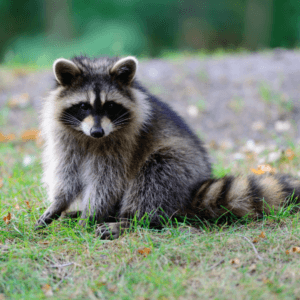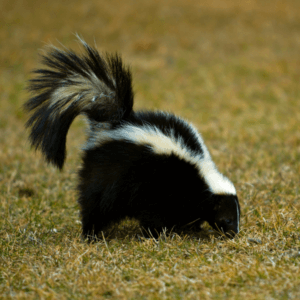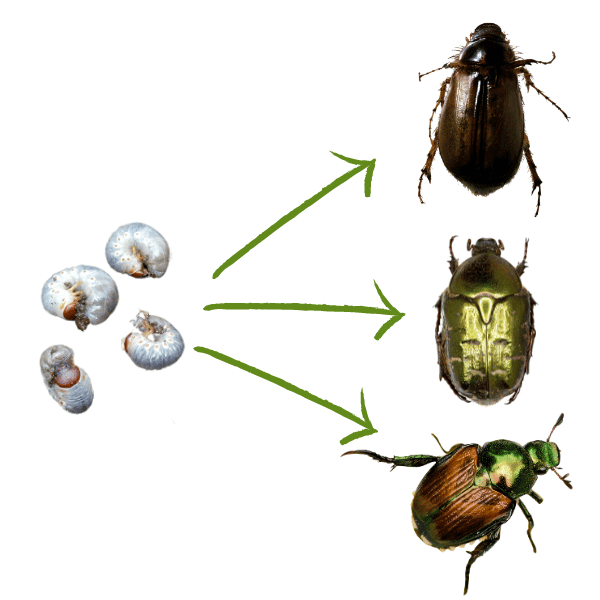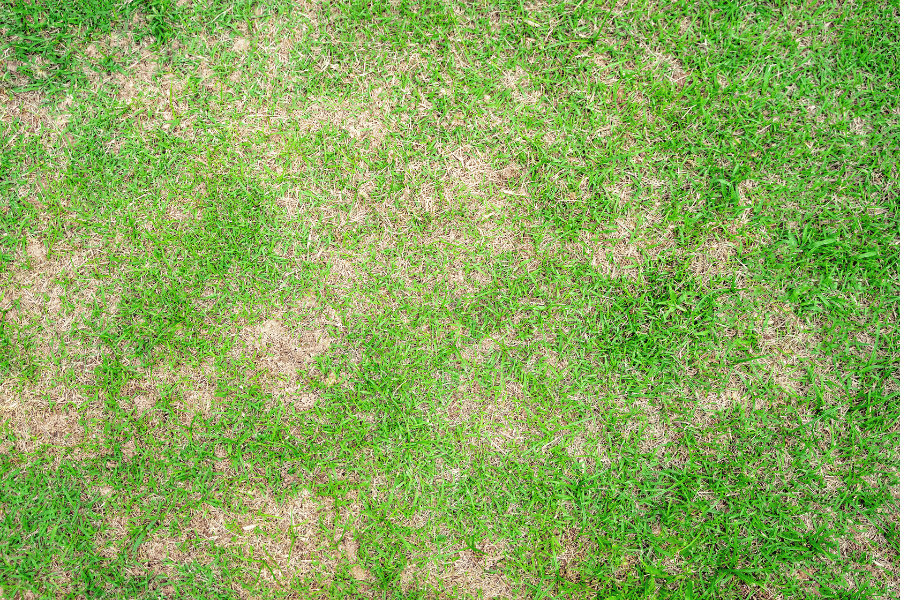Southern Ontario is filled with lush green landscapes and beautiful gardens. Maintaining a healthy lawn is a point of pride for many homeowners in the region. However, there’s a hidden threat lurking beneath the surface that can wreak havoc on your lawn if left unchecked – grubs. These voracious underground pests can cause significant damage to your turf, turning your once vibrant lawn into a patchy, brown mess.
First Thing’s First! Symptoms To Watch For
Grub damage in lawns can manifest in various ways, and recognizing the signs early is crucial for taking effective action. The severity of the damage can vary, but the following are common indicators of a grub infestation:
- Brown Patches: One of the most noticeable signs of grub damage is the appearance of brown patches or areas of dead or dying grass in your lawn. These patches might start small and gradually expand over time.
- Spongy or Loose Turf: When you walk on an area of the lawn affected by grubs, you may notice that the turf feels spongy or loose underfoot. This is because the grubs feed on the roots of the grass, causing the turf to become less firmly anchored in the soil.
- Irregularly Shaped Dead Spots: Unlike other lawn issues, such as fungal diseases, grub damage tends to create irregularly shaped dead spots in your lawn. These patches might be randomly scattered, and the edges of the affected areas may appear ragged.
- Thinning Grass: As grubs continue to feed on the roots, the grass in the affected areas will become progressively thinner. This can make your lawn look sparse and less lush than usual.
- Increased Animal Activity: Skunks, raccoons, and birds are known to feed on grubs. If you notice an increase in these animals digging up your lawn, it could be a sign that they’re targeting the grubs beneath the surface.



It’s important to note that the damage caused by grubs can be mistaken for other lawn issues, such as drought stress or disease. However, if you suspect grub damage, especially if you’ve had previous issues with grubs, it’s essential to investigate further.
To confirm the presence of grubs and accurately assess the level of infestation, you can perform a simple test:
- Choose a Problem Area: Select an area where you suspect grub damage or where the grass appears weak and unhealthy.
- Gently Lift the Turf: Using a shovel or trowel, lift a section of the affected grass, making sure to lift both the grass and the underlying soil.
- Check for Grubs: Look for white or grayish, C-shaped larvae in the soil. If you find more than a few grubs (typically 5-10 per square foot), it’s an indication of a potential grub problem.
If you confirm the presence of grubs or suspect significant damage, it’s crucial to take action promptly to prevent further destruction to your lawn. Implementing grub control measures, during the appropriate time of the year can help restore and protect the health of your lawn.
Understanding Grubs: The Culprits Behind Lawn Damage
 Grubs are the larval stage of various beetle species, with the Japanese beetle and the European chafer beetle being the most common culprits in Southern Ontario. These pests feed on the roots of grass plants, depriving them of essential nutrients and water. As grubs feed, they create tunnels in the soil, further weakening the grass’s root system and creating an environment ripe for other lawn issues like thatch and disease. The result is a lawn that becomes increasingly vulnerable to drought stress, foot traffic, and general wear and tear.
Grubs are the larval stage of various beetle species, with the Japanese beetle and the European chafer beetle being the most common culprits in Southern Ontario. These pests feed on the roots of grass plants, depriving them of essential nutrients and water. As grubs feed, they create tunnels in the soil, further weakening the grass’s root system and creating an environment ripe for other lawn issues like thatch and disease. The result is a lawn that becomes increasingly vulnerable to drought stress, foot traffic, and general wear and tear.
The Grub Control Timeline
Effective grub control requires understanding their life cycle. Grubs hatch from eggs laid by adult beetles in mid-summer. They then spend the late summer and early fall months feasting on your lawn’s roots before burrowing deep into the soil to survive the winter. In the spring, they return to the surface to feed for a short time before pupating and emerging as adult beetles, completing the cycle.
- Egg Stage: Adult beetles, such as Japanese beetles or European chafer beetles, lay eggs in the soil, usually in mid-summer. These eggs are small, white, and spherical.
- Larval Stage (Grub): After the eggs hatch, the larvae, known as grubs, emerge. Grubs are typically C-shaped, cream-colored or grayish, with a distinct brown head. They have six well-developed legs near their head, which they use for feeding.
- Feeding Stage: Grubs feed voraciously on the roots of grass plants during the late summer and early fall months. They create tunnels in the soil as they feed, which weakens the grass’s root system and can lead to significant lawn damage.
- Overwintering: As the temperatures drop in the fall, grubs move deeper into the soil to overwinter. They burrow down to avoid the colder surface conditions, staying dormant during the winter months.
- Pupal Stage: In the spring, grubs return closer to the surface and enter the pupal stage. This is another point in their life cycle when they are feeding and susceptible to treatments. During this stage, they transform into adult beetles inside a protective pupal case.
- Adult Stage: Once the transformation is complete, the adult beetles emerge from the soil. They mate and begin the cycle again by laying eggs in the soil, continuing the life cycle.
Understanding this life cycle is essential for effective grub control, as targeting the grubs during their vulnerable feeding stage is the key to preventing significant lawn damage. Implementing preventive measures or treatment during the appropriate time of the year can help protect your lawn from the destructive effects of grubs.
Preventive Measures: Nipping Grub Problems in the Bud
- Proper Lawn Maintenance: A well-maintained lawn is more resistant to grub damage. Regular mowing at the appropriate height, adequate watering, and proper fertilization can help keep your grass strong and resilient.
- Less Stress: A lawn that is stressed, is more likely to be a home to grubs. Even just the presence of a much-loved shade tree competing with the lawn for moisture can put the turf in a compromised state. Water lawns well where companion plantings are competing.
- Aerate the Soil: Aerating your lawn in the fall helps improve soil structure and allows water and nutrients to reach the grass roots more effectively. It also disrupts the grubs’ feeding patterns, making them more susceptible to treatment.
If preventative action didn’t deter grubs, then treatment will be necessary to eradicate this underground pest. Also, if you’ve had previous issues with grubs or want to take extra precautions, there are several effective grub control treatments available:
- Biological Control: Beneficial nematodes are microscopic organisms that can be applied to your lawn to target and kill grubs. These nematodes are a natural and environmentally friendly solution.
- Chemical Treatments: There are chemical products designed specifically for grub control. These products should be applied in late summer to early fall to target the young grubs during their most vulnerable stage. Always follow the manufacturer’s instructions and use caution when using chemical treatments.
- Professional Lawn Care Services: If you’re unsure about how to handle grub control on your own, or if you’re dealing with a severe infestation, consider hiring a professional lawn care service. They have the expertise and resources to assess your lawn’s specific needs and apply the appropriate treatment.
Grub control is a crucial aspect of maintaining a healthy and vibrant lawn. By understanding the life cycle of grubs and implementing preventive measures, you can effectively protect your lawn from these subterranean invaders. Whether you choose to take a DIY approach or enlist the help of professionals, the key is to act proactively to ensure your lawn remains a source of pride for years to come. Our experts are always ready to help you identify pests and recommend the best course of action. Once you’ve treated for grubs, overseeding your lawn or re-sodding can begin.




